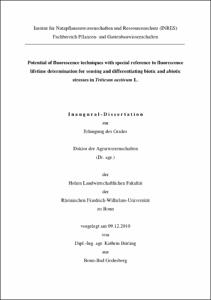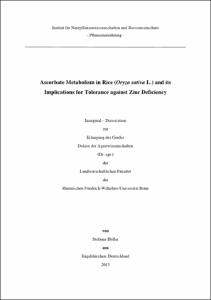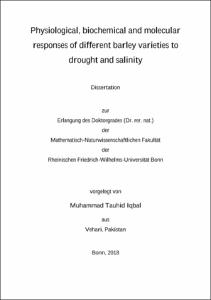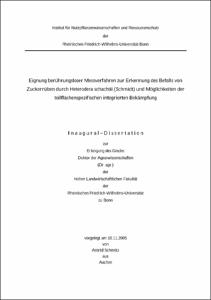Bürling, Kathrin: Potential of fluorescence techniques with special reference to fluorescence lifetime determination for sensing and differentiating biotic and abiotic stresses in Triticum aestivum L.. - Bonn, 2011. - Dissertation, Rheinische Friedrich-Wilhelms-Universität Bonn.
Online-Ausgabe in bonndoc: https://nbn-resolving.org/urn:nbn:de:hbz:5N-25907
Online-Ausgabe in bonndoc: https://nbn-resolving.org/urn:nbn:de:hbz:5N-25907
@phdthesis{handle:20.500.11811/4741,
urn: https://nbn-resolving.org/urn:nbn:de:hbz:5N-25907,
author = {{Kathrin Bürling}},
title = {Potential of fluorescence techniques with special reference to fluorescence lifetime determination for sensing and differentiating biotic and abiotic stresses in Triticum aestivum L.},
school = {Rheinische Friedrich-Wilhelms-Universität Bonn},
year = 2011,
month = jul,
note = {The key objective of the present thesis was to early assess physiological modifications of wheat plants due to biotic and abiotic stresses by means of non-destructive fluorescence measurement techniques.
Experiments at leaf level were conducted under laboratory conditions, whereupon two economical important biotrophic fungi in wheat production, Puccinia triticina and Blumeria graminis, as well as nitrogen deficiency as the most significant factor in terms of nutrient management, were selected for representative studies.
Experiments with the PAM-imaging system showed that the quantum yield of non-regulated energy dissipation in PSII (Y(NO)) is the most promising parameter for screening wheat plants for leaf rust resistance. Measurements revealed a stronger pathogen-triggered increase of the Y(NO) values in the susceptible than in the resistant cultivar. Thereby, the most appropriate time for a reliable differentiation between was two days after inoculation. Preliminary experiments with densities of up to 20 000 spores per ml in case of fast fluorescence kinetic parameters, and up to 100 000 spores per ml in case of slow kinetic parameters, revealed that changes in the fluorescence signals were not related to physical masking.
The assessment of fluorescence lifetime and UV-induced spectra were adopted for the detection of leaf rust (Puccinia triticina) in three resistant in comparison to four susceptible cultivars. A combination of spectral and lifetime characteristics revealed pre-symptomatic alterations of fluorescence indicating changes in the content of chlorophyll and secondary metabolites. The determination of the B/G amplitude ratio seemed to be the most appropriate parameter for early detection of fungal infection. Discrimination between resistant and susceptible cultivars to the leaf rust pathogen might be feasible by monitoring the amplitude ratio of B/R fluorescence at three days after inoculation. In addition, mean lifetime at 440, 500 and 530 nm should be considered; these parameters revealed a more pronounced difference between control and inoculated leaves in the resistant cultivars.
UV-induced spectral signature as well as mean fluorescence lifetimes are suitable approaches for sensing powdery mildew (Blumeria graminis) as early as one day after inoculation. The decreased amplitude ratio B/G as well as the increased G/R and G/FR half-bandwidth ratios in inoculated as compared to control leaves, were appropriate parameters to detect fungal development. In addition, the increased mean lifetime in inoculated leaves in the wavelength range of 500-620 nm may enable a distinction between healthy and diseased leaves. Additional experiments revealed an increased mean lifetime of the green fluorescence as early as ten to twelve hours after the first host-pathogen interaction.
Fluorescence intensity measured between 370 and 800 nm provided to be a useful tool to address the challenge of discrimination between nitrogen deficiency and fungal diseases. Precisely, the amplitude ratio R/FR was suited for early detection, and gives a basis for discrimination between N-full-supply, N-deficiency, N-full-supply + pathogen and N-deficiency + pathogen. In addition, the blue-green fluorescence yielded important information targeting a possible discrimination between the evaluated multiple stress factors. Besides, several more fluorescence amplitude ratios and half-bandwidth ratios for leaf rust as well as half-bandwidth ratios for powdery mildew were found to be applicable for early detection of both leaf rust and powdery mildew infection, irrespective of the nitrogen status of the plants.},
url = {https://hdl.handle.net/20.500.11811/4741}
}
urn: https://nbn-resolving.org/urn:nbn:de:hbz:5N-25907,
author = {{Kathrin Bürling}},
title = {Potential of fluorescence techniques with special reference to fluorescence lifetime determination for sensing and differentiating biotic and abiotic stresses in Triticum aestivum L.},
school = {Rheinische Friedrich-Wilhelms-Universität Bonn},
year = 2011,
month = jul,
note = {The key objective of the present thesis was to early assess physiological modifications of wheat plants due to biotic and abiotic stresses by means of non-destructive fluorescence measurement techniques.
Experiments at leaf level were conducted under laboratory conditions, whereupon two economical important biotrophic fungi in wheat production, Puccinia triticina and Blumeria graminis, as well as nitrogen deficiency as the most significant factor in terms of nutrient management, were selected for representative studies.
Experiments with the PAM-imaging system showed that the quantum yield of non-regulated energy dissipation in PSII (Y(NO)) is the most promising parameter for screening wheat plants for leaf rust resistance. Measurements revealed a stronger pathogen-triggered increase of the Y(NO) values in the susceptible than in the resistant cultivar. Thereby, the most appropriate time for a reliable differentiation between was two days after inoculation. Preliminary experiments with densities of up to 20 000 spores per ml in case of fast fluorescence kinetic parameters, and up to 100 000 spores per ml in case of slow kinetic parameters, revealed that changes in the fluorescence signals were not related to physical masking.
The assessment of fluorescence lifetime and UV-induced spectra were adopted for the detection of leaf rust (Puccinia triticina) in three resistant in comparison to four susceptible cultivars. A combination of spectral and lifetime characteristics revealed pre-symptomatic alterations of fluorescence indicating changes in the content of chlorophyll and secondary metabolites. The determination of the B/G amplitude ratio seemed to be the most appropriate parameter for early detection of fungal infection. Discrimination between resistant and susceptible cultivars to the leaf rust pathogen might be feasible by monitoring the amplitude ratio of B/R fluorescence at three days after inoculation. In addition, mean lifetime at 440, 500 and 530 nm should be considered; these parameters revealed a more pronounced difference between control and inoculated leaves in the resistant cultivars.
UV-induced spectral signature as well as mean fluorescence lifetimes are suitable approaches for sensing powdery mildew (Blumeria graminis) as early as one day after inoculation. The decreased amplitude ratio B/G as well as the increased G/R and G/FR half-bandwidth ratios in inoculated as compared to control leaves, were appropriate parameters to detect fungal development. In addition, the increased mean lifetime in inoculated leaves in the wavelength range of 500-620 nm may enable a distinction between healthy and diseased leaves. Additional experiments revealed an increased mean lifetime of the green fluorescence as early as ten to twelve hours after the first host-pathogen interaction.
Fluorescence intensity measured between 370 and 800 nm provided to be a useful tool to address the challenge of discrimination between nitrogen deficiency and fungal diseases. Precisely, the amplitude ratio R/FR was suited for early detection, and gives a basis for discrimination between N-full-supply, N-deficiency, N-full-supply + pathogen and N-deficiency + pathogen. In addition, the blue-green fluorescence yielded important information targeting a possible discrimination between the evaluated multiple stress factors. Besides, several more fluorescence amplitude ratios and half-bandwidth ratios for leaf rust as well as half-bandwidth ratios for powdery mildew were found to be applicable for early detection of both leaf rust and powdery mildew infection, irrespective of the nitrogen status of the plants.},
url = {https://hdl.handle.net/20.500.11811/4741}
}









